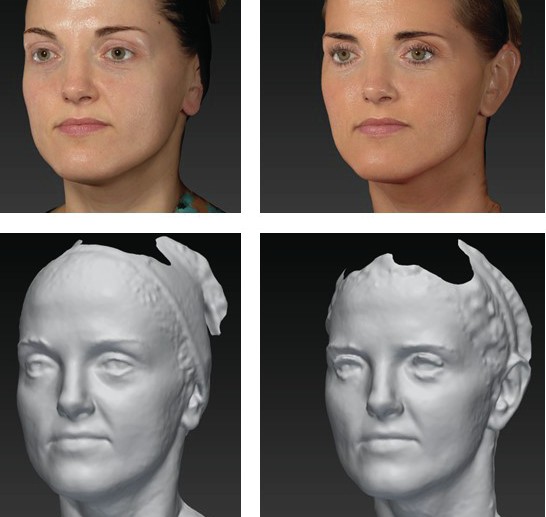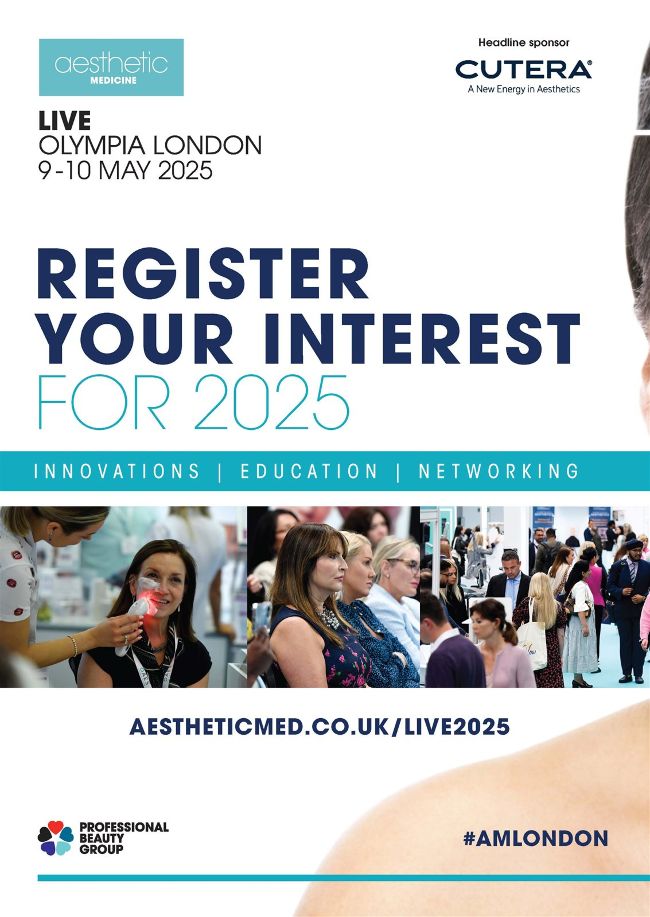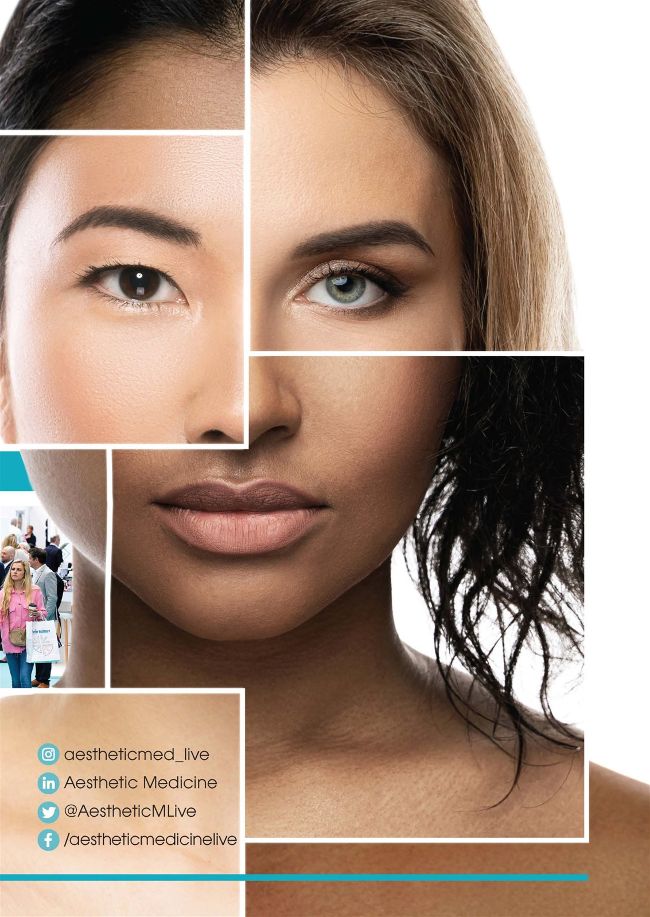CLINICAL
WHERE SURGERY DOESN’T MAKE THE cut
Dr Rachna Murthy and Dr Jonathan Roos describe their periocular rejuvenation technique using combination therapy and collagen banking
DR JONATHAN ROOS
Dr Jonathan Roos is a Harvard and Cambridge-trained consultant eyelid surgeon specialising in periocular skin cancer and facial aesthetics. He has published in the world’s top-ranked medical journals, operated for charity in Africa and is ranked as a leader in plastic surgery by Tatler magazine. In his free time, he teaches his sons to swim with whales and sails across the Atlantic with his wife.
DR RACHNA MURTHY
Miss Rachna Murthy is one of the UK’s leading experts in the management of aesthetic filler complications. She has won numerous awards including UK Consultant Surgeon of the Year and, for a decade, led a world-leading clinical service at Cambridge University Hospitals. She is regularly listed by Tatler magazine as among the UK’s leading eyelid surgeons and is invited to chair international meetings. Together with Dr Roos, she has published five textbook chapters in the last two years. he demand for non-invasive aesthetic treatments
Tcontinues to grow rapidly, with an increasing focus on combination therapies that provide naturallooking results with minimal downtime.
In 2023, 7.7 million people in the UK had an aesthetic treatment, representing 11% of the population, with projections suggesting the UK aesthetic industry could be worth £5.4 billion by 2026.1 This surge in popularity is driven by advancements in technology, increased affordability, and changing societal attitudes towards cosmetic procedures.
The periocular area is a common concern for patients seeking rejuvenation; it is usually the first areas to show signs of ageing and an area where treatments must be carefully and expertly executed to avoid long-term complications such as migration, Tyndall, malar oedema and filler saturation. The eyes signal health, age, mood and identity and each of these is key to how we communicate our place in society.
Combination therapy, using polynucleotides, hybrid hyaluronic acid (HA) and calcium hydroxyapatite (CaHA), as well as traditional HA fillers, has emerged as a promising approach to address multiple aspects of periocular ageing simultaneously. This ‘less is more’ approach aims to achieve optimal outcomes by strategically combining different modalities, each targeting specific aspects of rejuvenation.
CASE REPORT
Patient: Our patient, a 38-year-old female, presented with concerns about periocular ageing, including dark under eye circles, fine lines, and skin laxity. The thin skin in her periocular area made her vessels more visible underneath. She had no significant medical history and had not had any previous aesthetic treatments.
Clinical findings: When examined, we found moderate tear trough deformities, visible fine lines around the eyes, and mild skin laxity in the periocular area. The Global Aesthetic Improvement Scale (GAIS) score was three, indicating moderate improvement needed.
Diagnostic assessment: A comprehensive facial analysis was performed, including standardised photography and 3D Vectra imaging. The modified Tear Trough Rating Scale was used to assess the severity of the tear trough deformity, with the patient scoring a three out of five.

Therapeutic intervention: A combination therapy approach was designed to address the patient’s concerns as shown in the image:
1. Hybrid HA-CaHA (shown in blue on diagram): 0.6ml (per side of the face) of a premixed combination of CaHA and HA (HArmonyCA, Allergan/Abbvie) was injected along the zygomatic arch, immediately sub-dermally, using a 22G cannula, in an anteroand retrograde motion, as well as fanned immediately sub-dermally below the zygomatic arch. This hybrid filler was chosen for its dual-action rejuvenation properties, providing immediate volume and long-term collagen stimulation.
2. HA Filler (purple): 0.3ml of a high-viscosity, high G’ HA filler (Juvederm Voluma, Allergan/Abbvie) was injected into the deep medial fat pad, fanning retrograde using a 25G cannula to address the tear trough indirectly with medial deep volume. 0.2ml per side was also injected below the HArmonyCA above the zygomatic arch with a 25G cannula. The treatments were performed in a single session, with the polynucleotides injected first, followed by the hybrid filler, and finally the HA filler. Local anesthesia was not used as we use a combination of Target Cool cooling for needle entry and vibration (using the Gate theory of pain) to ensure patient comfort.
3. Polynucleotides (green): 1ml of polynucleotide solution was injected into the periocular area using a 25G cannula, focusing on the tear trough and lateral orbital rim. Alateral needle entry was made 3mm lateral to the lateral orbital rim and the cannula inserted immediately sub-dermally. Within each lower eyelid area 0.5ml of Philart Eye (Croma) was injected with a slow technique to distribute the solution, homogenously, without discomfort while always visualising the cannula tip under the skin. This was done to promote cellular repair, stimulate collagen production and improve skin quality.
Follow-up and outcomes: The patient was assessed at two weeks and six months post-treatment. At the two-week follow-up, the immediate mild swelling and erythema that were observed straight after injection had resolved completely, and our patient was very satisfied with the result. At three months, significant improvement in tear trough appearance, skin quality, and fine lines. The GAIS score improved to one, indicating significant improvement. At the six-month follow-up, the patient reported high satisfaction with the results. The modified Tear Trough Rating Scale score improved to one, and 3D imaging showed increase in midface volume. Skin elasticity was not measured with a cutometer, however the patient reported significant improvement.
DISCUSSION
This case report demonstrates the efficacy of combination therapy using polynucleotides, hybrid HA-CaHA, and HA fillers for periocular rejuvenation. The synergistic effects of these treatments address multiple aspects of ageing, including volume loss, skin quality, and fine lines.
Polynucleotides have gained popularity due to their ability to promote cellular repair and improve skin quality with minimal side effects. They work by stimulating fibroblast activity and enhancing extracellular matrix production, leading to improved skin texture and elasticity.
The use of hybrid HA-CaHA fillers is an innovative approach that combines the immediate volumising effect of HA with the long-term collagen-stimulating properties of CaHA.
A study by Goldie et al. demonstrated that this combination can provide effective volumisation and lifting of the midface and jawline for up to 18 months.2 Indirect treatment of the tear trough with HA fillers are particularly suitable for the delicate periocular area, as they can be injected away from the lymphatics to address improvement in mid-face volume without risking migration, Tyndall and malar oedema, creating a natural appearance. This aligns with the ‘less is more’ approach, which aims to achieve natural-looking results with minimal product use. The combination of these treatments allows for a comprehensive approach to periocular rejuvenation. Polynucleotides improve overall skin quality, the hybrid filler provides structural support and volume, and the HA filler addresses volume deficit. This multi-modal approach can lead to more satisfactory and longer-lasting results compared to single-modality treatments.
A review of the literature supports the efficacy of these individual components. A study by Cavallini et al. showed that polynucleotide injections led to significant improvements in skin elasticity and hydration in the periocular area.3 The use of CaHA for periorbital rejuvenation has been documented by Braz et al., who reported high patient satisfaction and long-lasting results.4 While the results of this case report are promising, it is important to note potential complications associated with periocular treatments. These may include bruising, swelling, asymmetry, Tyndall, filler saturation, malar oedema and in rare cases, vascular occlusion. Proper injection technique, thorough knowledge of anatomy, and appropriate patient selection are crucial to minimise these risks. The timing of treatments is also an important consideration. In this case, all treatments were performed in a single session. However, some practitioners may prefer a staged approach, allowing for assessment of results between treatments. The optimal timing and sequencing of combination therapies warrant further investigation.
As the demand for non-invasive aesthetic treatments continues to grow, combination therapies offer a sophisticated approach to achieving natural-looking results. The use of polynucleotides, hybrid HA-CaHA, and HA fillers for periocular rejuvenation demonstrates the potential for comprehensive improvement with minimal downtime, and bio-stimulation of tissue for long lasting results where surgery doesn’t make the cut.
REFERENCES
1. Aesthetics industry UK statistics 2023 -PolicyBee https://policybee.co.uk/blog/aesthetics-industry-statistics
2. Goldie K, Peeters W, Alghoul M, Butterwick K, Casabona G, Chao YYY, Costa J, Eviatar J, Fabi SG, Lupo M, Sattler G, Waldorf H, Yutskovskaya Y, Lorenc P. Global Consensus Guidelines for the Injection of Diluted and Hyperdiluted Calcium Hydroxylapatite for Skin Tightening. Dermatol Surg. 2018 Nov;44 Suppl 1:S32-S41. doi: 10.1097/ DSS.0000000000001685. Erratum in: Dermatol Surg. 2019;45(2):327.
3. Cavallini M, Bartoletti E, Maioli L, Massirone A, Pia Palmieri I, Papagni M, Priori M, Trocchi G; As Members of The Polynucleotides HPT™ Priming Board, Collegio Italiano delle Società Scientifiche di Medicina Estetica (Italian College of the Aesthetic Medicine Scientific Societies) -SIME, AGORÀ, SIES. Consensus report on the use of PN-HPT™ (polynucleotides highly purified technology) in aesthetic medicine. JCosmet Dermatol. 2021 Mar;20(3):922-928. doi: 10.1111/jocd.13679. Epub 2020 Sep 21. PMID: 32799391;
4. Braz A, de Paula Eduardo CC, Pierce A, Grond A, Kutikov A, Nakab L. A Novel Hybrid Injectable for Soft-tissue Augmentation: Analysis of Data and Practical Experience. Plast Reconstr Surg Glob Open. 2024 Sep 19;12(9):e6190.

